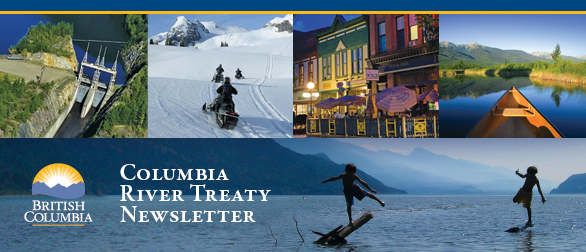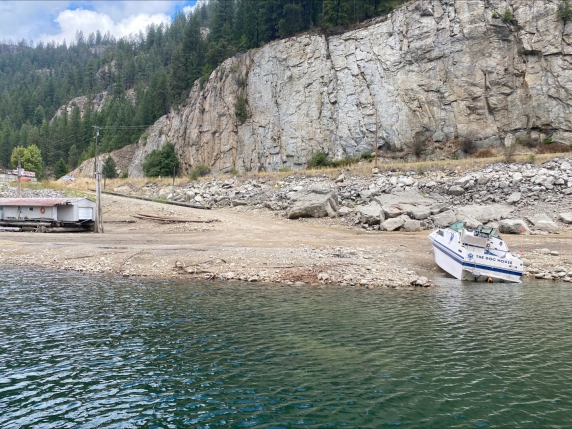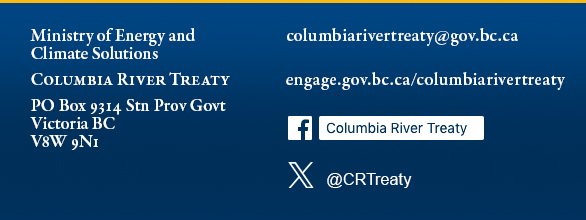Columbia River Treaty
Edition: April 2024

2023’s Low Water Levels in Arrow Lakes Reservoir
Apr 29, 2024

Scottie’s Marina near Syringa Provincial Park on Arrow Lakes Reservoir, August 2023
Arrow Lakes Reservoir is part of an interconnected system of waterways in the Canadian Columbia Basin depended on by many forms of life, both in and out of the water. It is also one of three reservoirs in B.C. created by dams built under the Columbia River Treaty. Operation of the Treaty dams requires holding and releasing water to manage downstream flood risk and enable hydropower generation, inherently resulting in fluctuating reservoir elevations. It should be noted, though, that the Arrow Lakes did fluctuate seasonally in their natural state before the dam was built. Water levels are also subject to changes in climate and weather patterns. Last year, conditions were particularly challenging as the severe province-wide drought, combined with Columbia River Treaty requirements, resulted in dramatic seasonally low water levels on Arrow Lakes Reservoir.
Low snowpacks in the winter of 2022/23, early snowmelt last spring, and the provincial drought and lack of rainfall over the summer and fall, significantly reduced the amount of water flowing into Arrow Lakes Reservoir last year. At the same time, B.C. was still required to meet its obligations under the Treaty to provide a certain volume of water to the U.S. for flood risk management purposes and downstream power generation. The Treaty requirement is another factor that contributed to the severe drafting on Arrow Lakes last year over the later part of the summer and fall. Canada is required to release more water during dry conditions in the U.S. to enable the U.S. to meet their firm energy requirements.
Additionally, water releases from Kinbasket Reservoir that might otherwise have kept Arrow Lakes Reservoir levels higher were managed, similar to other low inflow years, to ensure sufficient water storage was available for winter energy supply at Revelstoke and Mica Generating Stations.
Last year’s levels in August, September, and October had not been observed in those months since the mid 1970s. Although within water licence limits, the very low levels and the decline over July and August resulted in grounded boats and docks, compromised beach access, stranded fish, exposed materials and structures, and dust storms, highlighting the impacts on local communities and ecosystems, and causing great concern among residents. The situation also emphasized the need to make changes to the Treaty.
As Canada, B.C. and the Ktunaxa, Secwépemc and Syilx Okanagan Nations seek to negotiate a modernized Treaty with the U.S., they are strongly advocating for improvements that would reduce the type of impacts seen on Arrow Lakes Reservoir, not just last year but since the Treaty was created. Kathy Eichenberger, B.C.’s lead on the Canadian negotiation delegation, said in an Opinion Editorial last fall that “The Canadian negotiation delegation is acutely aware of the low water levels on Arrow Lakes Reservoir … and the devastating impact this is having on communities, wildlife habitat, fish populations, tourism and recreation. …we have shared this with our U.S. counterparts so they may have a clearer understanding of our positions.” Katrine Conroy, B.C.’s Minister of Finance and Minister Responsible for the Columbia River Treaty, also emphasized this point in a separate Opinion-Editorial. Both underscored how critical it is for a modernized Treaty to include additional flexibility for how B.C. operates its Treaty dams. This would enable B.C. to adjust its operations (and resulting reservoir levels and river flows) to support ecosystems, Indigenous cultural values, and socio-economic interests (like recreation and tourism) in the B.C. Basin, while continuing to protect communities from damaging floods and enable generation of clean hydroelectricity.
The Province hosted a virtual information session last October to provide information about the low water levels and efforts underway to reduce impacts in the future. Presenters from the Government of B.C., the Canadian Columbia River Treaty negotiation team, BC Hydro, and the Columbia River Treaty Local Governments Committee were joined by over 200 people from communities around Arrow Lakes Reservoir and beyond, including Nakusp, Fauquier, Edgewood, Revelstoke, Castlegar and others. Participants asked questions and voiced concerns about a range of topics including cleanup of shoreline debris, the rate and volume of reservoir outflows, objectives for modernizing the Columbia River Treaty, plans to mitigate impacts in the short and long term, and much more.
The B.C. Columbia River Treaty Team and BC Hydro have completed a detailed report in PDF and mobile-friendly formats, responding to all relevant questions posed before and during the event, offering important context around Treaty requirements, BC Hydro operations, and Canada-U.S. negotiations to modernize the Treaty.
The report, information session recording, and presentation materials can all be found on the B.C. Columbia River Treaty website.


